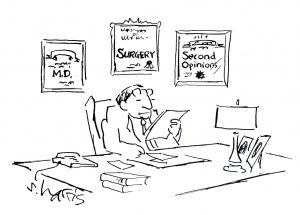“Digital Pathology Stands to Reduce Cancer Misdiagnoses”
 With the ink dry about a month on the recent FDA approval of Philips Intellisite Pathology Solution (PIPS) for primary diagnosis, I came across this headline and others like it last week. Well known, respected pathologists and pathology informaticians at well-known cancer centers provided quotes for the articles. When you contribute to an article, you can’t always control all the content and what the finished version may be or even what the headline may read or suggest and this is not to critique articles, authors or pathologists, but instead remain cognizant to what digital pathology is, can and can’t do. This particular headline was on CBS New York among other syndicated sources.
With the ink dry about a month on the recent FDA approval of Philips Intellisite Pathology Solution (PIPS) for primary diagnosis, I came across this headline and others like it last week. Well known, respected pathologists and pathology informaticians at well-known cancer centers provided quotes for the articles. When you contribute to an article, you can’t always control all the content and what the finished version may be or even what the headline may read or suggest and this is not to critique articles, authors or pathologists, but instead remain cognizant to what digital pathology is, can and can’t do. This particular headline was on CBS New York among other syndicated sources.
Perhaps most frustrating, as it relates to second opinions as these recent articles published focused on, the popular press seems fond of quoting a misdiagnosis rate of 30% – between benign and malignant diagnosis or vice-versa.
I don’t know where this number comes from but guessed it was far short of that. In fact, with a quick PubMed search, there was a University of Iowa study that looked at over 5000 second opinion cases and found a major disagreement in 2.3% of cases and a Mayo Clinic study that looked at over 71000 cases had a major disagreement rate of less than 1%. There are a number of papers looking at specific subspecialties and/or referral practices that were as high as 9% in my quick review. But not 30%. Nonetheless, everyone agrees for a malignant diagnosis, rare diagnosis, unusual diagnosis, common diagnosis presenting uncommonly or common diagnosis presenting uncommonly, many clinicians and pathologists would encourage second opinions.
This article goes on to mention “It is a huge improvement over the decades-old technique of placing tumor cells on glass slides for an examination under a microscope, getting them processed and mailed for review by specialists could take days, or even weeks.”
This is so poorly described and written I do not know where to start. Chances are the tissue was processed within a day and skillfully placed on a microscope slide or slides and reviewed by the next day or two on a light microscope with a diagnosis rendered. For those of us who can, perhaps 1 of our 4 or 5 or 10 or 20 or more colleagues within our institution provide their opinion. And if necessary, the case is referred to another specialist for his/her opinion which is generally completed within a few days. It of course may take longer with additional stains but turnaround time is measured in days, not weeks.
The last referral center I know that took weeks to turn around a case was the Armed Forces Institute of Pathology (AFIP) which is likely one reason they are not in the consult business anymore (outside of DOD and VA cases).
But more to the point — we have had the ability to use digital pathology for consultations in surgical pathology for as long as we have had digital pathology. Consults were never an issue. Primary diagnosis was the issue.
The Philips study showed, as others showed from Cleveland Clinic and the United Kingdom (UK), amongst the largest published studies in recent years, among dozens of other smaller studies, that whole slide imaging and digital diagnosis are not inferior to the light microscope.
In the UK study, re-examination of over 10000 scanned slides produced 72 variances between glass slide digital pathology reports, including 21 clinically significant variances. Ground truth lay with glass slides in 12 cases and with digital pathology in nine cases.
In the Cleveland Clinic Study, the major and minor discrepancy rates for whole slide imaging were 1.65% and 2.31%, whereas rates for microscope slide reviews were 0.99% and 4.93%.
Both studies concluded, as did the Philips study, that digital pathology/diagnoses is/are not inferior to light microscope/optical diagnoses.
It took a long time to get regulators to be convinced that digital pathology was no different from light microscopy.
I hope that patients do not begin to think that digital pathology is superior to the light microscope, each with inherent error rates and comparable between them. And that popular press articles do not try to convey, that while this “new technology” may allow for more rapid reviews than a day or two, it will not “reduce cancer misdiagnoses” that are overestimated.


































